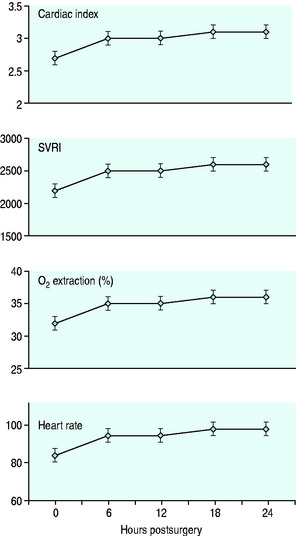Chapter 22 Intensive care after cardiac surgery
Coronary artery bypass surgery is one of the most frequently undertaken surgical procedures. Because of the prevalence of cardiac disease, cardiac surgery has significant health and economic implications. Intensive care may account for up to 40% of the total hospital costs for these patients and much of the short-term morbidity and mortality is based on perioperative events.
CARDIOVASCULAR MANAGEMENT
Management is conveniently dictated by standardised protocols, which should cover investigations, fluid and electrolyte management, vasoactive and other drug administration and mechanical ventilation. Standardisation is probably more important than the particulars of the protocol, which might vary considerably among institutions. Optimal cardiovascular management requires a sound knowledge of normal and abnormal cardiovascular physiology. It also requires an understanding of the haemodynamic changes usually seen in the postoperative patient (Figure 22.1).1

Figure 22.1 Haemodynamic changes following cardiac surgery. Systemic vascular resistance index (SVRI).
MONITORING
Electrocardiography and continuous invasive blood pressure and central venous pressure monitoring are standard. Flotation pulmonary artery (PA) catheterisation has become somewhat controversial. It is now reasonably well established that PA catheterisation is safe but may not alter outcomes.2
FLUID AND ELECTROLYTE MANAGEMENT
RESUSCITATION FLUID
HYPOTENSION
Hypotension is both a consequence and a cause of myocardial dysfunction. The major causes include:
Other causes of low cardiac output state (Table 22.1) should be considered and excluded. Whatever the cause, hypotension frequently causes myocardial ischaemia and consequent heart failure, especially if it occurs in the first 12–24 hours postoperatively. Angiography during this time almost always shows a significant reduction in the calibre of native coronary arteries, indicating increased coronary resistance and, presumably, altered coronary vasodilator reserve. Treatment of hypotension is urgent if a spiral of ischaemia and heart failure is to be averted.
| Preload |
| Afterload |
| Myocardial function |
HYPERTENSION
Complications associated with hypertension include:
Significant postoperative hypertension is more common in patients having a history of hypertension and with cessation of β-blockade, but is reasonably common in the early postoperative period. Both absolute pressure and dp/dt are important factors in vascular injury. Vascular resistance declines over the first few hours (see Figure 22.1), so that therapy during this period is best undertaken with agents with a short duration of action. Nitroglycerine is theoretically more appropriate than nitroprusside because of the possibility of coronary steal with the latter agent.6 In practice, this is almost never apparent and nitroprusside appears to be more effective. Simple measures such as the provision of adequate analgesia and sedation should also be considered.
The target blood pressure varies with the indication. Excessive reduction of blood pressure risks reducing myocardial oxygen supply more than demand. Under most circumstances, a mean arterial pressure between 90 and 100 mmHg (12.0 and 13.5 kPa) seems optimal.7 Much lower target pressures may be applicable for the management of heart failure or in the presence of a vulnerable aorta, such as occurs with aortic trauma, dissection or aneurysm. Reduction of dp/dt with beta-blockade is more important than absolute blood pressure control in the management of aortic dissection.
LOW CARDIAC OUTPUT
The aetiology of a low cardiac output following heart surgery is diverse (see Table 22.1). The most common causes include:
Transient, reversible myocardial depression may follow an episode of acute ischaemia (preoperative or intraoperative) and is especially problematic where intraoperative myocardial protection has been difficult or suboptimal. Recognition of a low-output state in the absence of invasive monitoring may be difficult. Many of the usual signs of low output are also consequences of anaesthesia and surgery. Tachycardia may be obscured by drugs, hypothermia and heart disease, and even lactic acidosis may be an unreliable marker in this patient group.1
In the early postoperative period, a relatively low cardiac output may not warrant intervention, providing tissue oxygen delivery is adequate. Since beta-blockade is beneficial in the postoperative cardiac patient, beta-agonists should not be used unquestioningly. Nevertheless, optimisation of cardiac function does confer some benefit8 and intervention is clearly required when tissue oxygen delivery is inadequate.
MANAGEMENT OPTIONS
Stay updated, free articles. Join our Telegram channel

Full access? Get Clinical Tree





